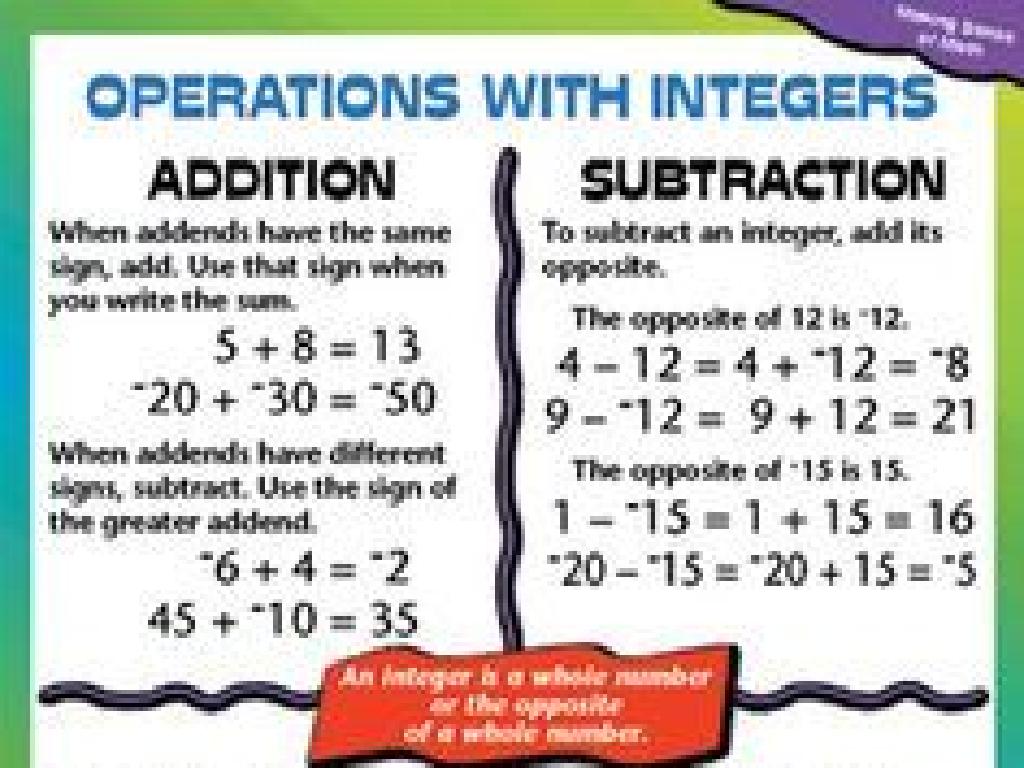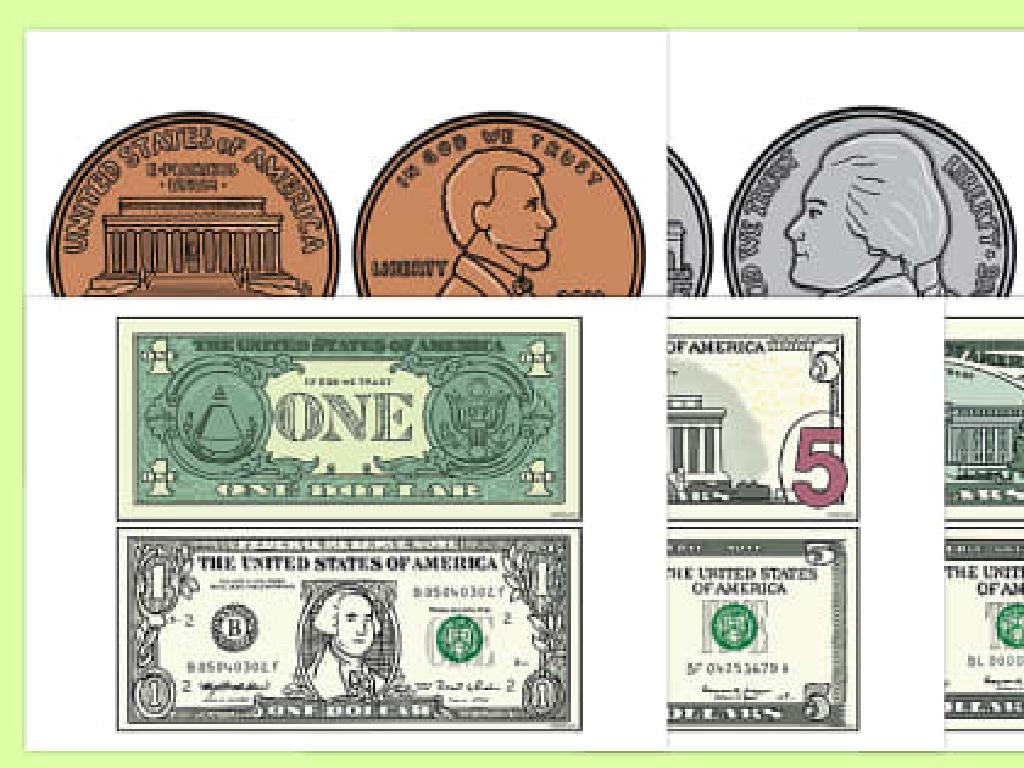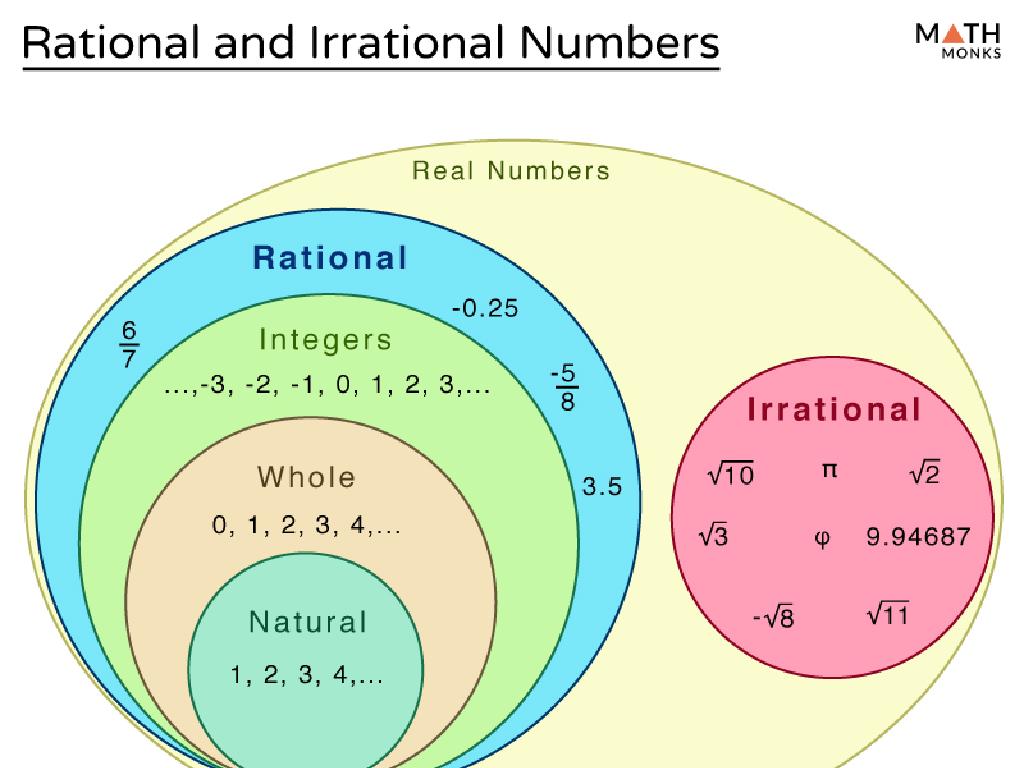Round To The Nearest Ten Or Hundred
Subject: Math
Grade: Third grade
Topic: Rounding
Please LOG IN to download the presentation. Access is available to registered users only.
View More Content
Welcome to Rounding Numbers!
– What is rounding?
– Rounding means finding the closest ten or hundred to a number.
– Why rounding matters
– Rounding makes numbers simpler to work with.
– Rounding to the nearest ten
– If the ones digit is 5 or more, round up. Less than 5, round down.
– Rounding to the nearest hundred
– Look at the tens digit. 5 or more, round up. Less than 5, round down.
|
This slide introduces students to the concept of rounding numbers, an essential skill in mathematics that simplifies numbers and makes them easier to work with. Start by explaining what rounding is and why it’s useful in everyday situations, such as estimating costs or distances. Today’s goal is to learn how to round numbers to the nearest ten or hundred. Provide clear examples for both cases, emphasizing the rule of rounding up or down based on the digit being 5 or more, or less than 5. Encourage students to think of situations where rounding might be helpful in their daily lives.
What is Rounding?
– Rounding makes numbers simpler
– Like making 14 into 10 or 20 to make adding easier
– Keeps value close to original
– Results are less accurate
– For example, 76 rounded to the nearest ten is 80
– Easier numbers to work with
– It’s like estimating to make math quicker
|
Rounding is a fundamental math skill that helps make complex calculations more manageable for third graders. It involves adjusting the number to a nearby, often easier to work with, value while maintaining a similar magnitude. This slide introduces the concept of rounding and emphasizes its practicality in everyday math. When teaching this lesson, use real-life scenarios such as estimating the total cost while shopping or shortening the time to the nearest hour to make the concept relatable. Encourage students to think of rounding as a tool for estimation that, while less precise, simplifies math operations like addition and subtraction.
Rounding to the Nearest Ten
– Examine the ones place digit
– Ones digit 5 or more, round up
– If a number ends in 5, 6, 7, 8, or 9, add one to the tens place
– Ones digit 4 or less, round down
– If a number ends in 0, 1, 2, 3, or 4, keep the tens place the same
– Practice with examples
– Example: Round 64 to the nearest ten
|
This slide introduces the concept of rounding numbers to the nearest ten. Start by explaining the importance of the ones place when rounding. If the ones digit is 5 or more, the number rounds up, meaning the tens digit increases by one, and the ones place changes to zero. If the ones digit is 4 or less, the number rounds down, and the tens place stays the same while the ones place becomes zero. Provide several examples for the students to work through, such as rounding 64 (which rounds up to 70) and 32 (which rounds down to 30). Encourage students to practice with different numbers and to explain their thought process as they determine how to round each number.
Rounding to the Nearest Ten
– Round down if ones = 5
– Example: 34 to 30
– 34 has 4 in the ones place, so it rounds down to 30.
– Example: 68 to 70
– 68 has 8 in the ones place, so it rounds up to 70.
|
This slide introduces students to the concept of rounding numbers to the nearest ten. Emphasize the rule that if the ones digit is less than 5, we round the number down, and if it’s 5 or more, we round the number up. Use the examples provided to illustrate this rule. For 34, since the ones digit is 4, which is less than 5, we round down to 30. For 68, the ones digit is 8, which is more than 5, so we round up to 70. Encourage students to practice with more examples and to explain their thinking process as they determine whether to round up or down.
Rounding to the Nearest Hundred
– Check the tens digit
– Tens digit 5 or more, round up
– If tens place is 5, 6, 7, 8, or 9, increase the hundreds place by 1.
– Tens digit 4 or less, round down
– If tens place is 0, 1, 2, 3, or 4, keep the hundreds place the same.
– Practice with examples
– Example: Round 354 to nearest hundred? Answer: 400
|
This slide introduces students to the concept of rounding numbers to the nearest hundred. Start by explaining the importance of the tens place when rounding to the nearest hundred. If the tens digit is 5 or more, the number is rounded up to the next hundred. If the tens digit is 4 or less, the number stays at the current hundred. Provide several examples for the students to practice, such as rounding 250 to 300 because the tens digit is 5, or rounding 142 down to 100 because the tens digit is 4. Encourage students to explain their thought process as they round each number. This will help solidify their understanding of the rounding rules.
Rounding to the Nearest Hundred
– Round 250 to the nearest hundred
– 250 becomes 300 because the tens digit (5) is 5 or more
– Round 449 to the nearest hundred
– 449 becomes 400 because the tens digit (4) is less than 5
– How to decide rounding up or down
– Practice with more examples
– Try rounding 350, 720, and 615
|
This slide is focused on teaching students how to round numbers to the nearest hundred. Start by explaining that the key to rounding is looking at the tens digit. If the tens digit is 5 or more, we round up to the next hundred. If it’s less than 5, we round down. Use the examples provided to illustrate this point. After explaining, engage the students with additional practice numbers to round as a class. Encourage them to explain their reasoning for each rounding decision. This will help solidify their understanding of the rounding concept.
Let’s Practice Rounding!
– Practice rounding together
– We’ll round numbers to the nearest ten or hundred
– I show a number
– Example: What is 34 rounded to the nearest ten?
– You tell the rounded number
– Is 34 closer to 30 or 40 when we round it?
|
This slide is designed to engage students in a hands-on rounding activity. Start by explaining that rounding helps us find the nearest ten or hundred to a given number. Show a number on the board and ask the students to round it to the nearest ten or hundred. For example, if the number is 34, guide them to see that it is closer to 30 than to 40, so the rounded number is 30. Encourage students to use number lines if they find it helpful to visualize the rounding process. Prepare several examples with varying difficulty and ensure to include numbers that are exactly in the middle, such as 45, to discuss how it rounds up to 50. This activity will help solidify their understanding of rounding concepts.
Class Activity: Let’s Play the Rounding Game!
– Pair up and roll a dice three times
– Create a three-digit number
– Choose to round to ten or hundred
– Write and explain your rounded number
– For example, if you roll 4, 5, 6, you get 456. Rounded to nearest ten is 460 and to nearest hundred is 500. Why did you choose ten or hundred?
|
This interactive activity is designed to help students understand the concept of rounding in a fun and engaging way. By working in pairs, they will roll a dice three times to create a random three-digit number. They will then decide whether it makes more sense to round their number to the nearest ten or the nearest hundred, fostering discussion and reasoning. After deciding, they should write down their rounded number and be prepared to explain their choice to the class, reinforcing their understanding of the rounding process. For the teacher: Prepare dice for each pair, ensure students understand the rules, and facilitate the activity. Walk around to assist pairs as needed. Have a few examples ready to demonstrate the activity. After the activity, discuss as a class some of the choices made and the reasoning behind them.
Rounding Mastery: Great Job!
– Congratulations on learning rounding!
– Rounding makes estimating easy
– Rounding to 10 or 100 helps simplify numbers
– Practice makes perfect in rounding
– The more you practice, the better you’ll get
– Aim to become a rounding expert!
|
This slide is a celebratory conclusion to the lesson on rounding to the nearest ten and hundred. It’s important to reinforce the concept that rounding is a valuable skill that simplifies numbers and makes them easier to work with, especially when estimating. Encourage the students to continue practicing with different numbers to become more confident in their rounding abilities. You can suggest playing rounding games, doing worksheets, or finding opportunities to round numbers in everyday situations, like when shopping or cooking, to help them see the practical applications of what they’ve learned.






